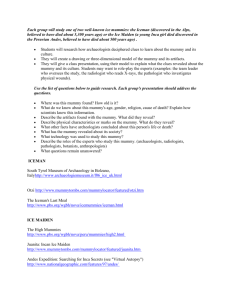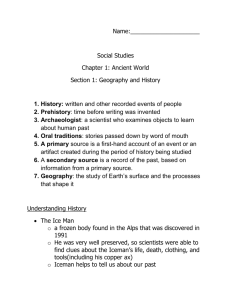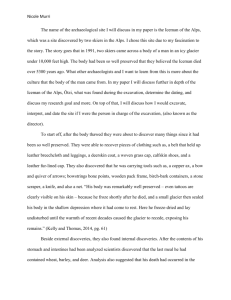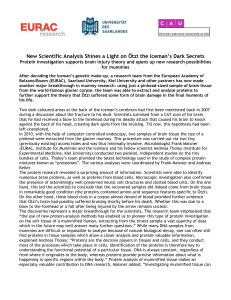Ötzi – the Iceman
advertisement
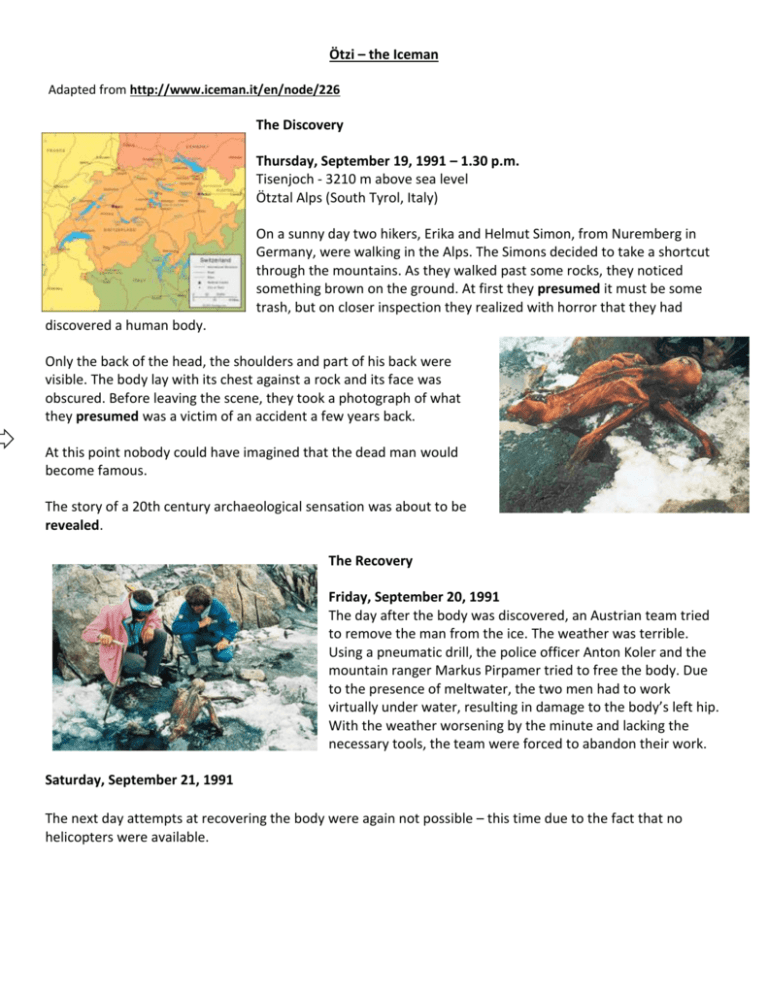
Ötzi – the Iceman Adapted from http://www.iceman.it/en/node/226 The Discovery Thursday, September 19, 1991 – 1.30 p.m. Tisenjoch - 3210 m above sea level Ötztal Alps (South Tyrol, Italy) On a sunny day two hikers, Erika and Helmut Simon, from Nuremberg in Germany, were walking in the Alps. The Simons decided to take a shortcut through the mountains. As they walked past some rocks, they noticed something brown on the ground. At first they presumed it must be some trash, but on closer inspection they realized with horror that they had discovered a human body. Only the back of the head, the shoulders and part of his back were visible. The body lay with its chest against a rock and its face was obscured. Before leaving the scene, they took a photograph of what they presumed was a victim of an accident a few years back. At this point nobody could have imagined that the dead man would become famous. The story of a 20th century archaeological sensation was about to be revealed. The Recovery Friday, September 20, 1991 The day after the body was discovered, an Austrian team tried to remove the man from the ice. The weather was terrible. Using a pneumatic drill, the police officer Anton Koler and the mountain ranger Markus Pirpamer tried to free the body. Due to the presence of meltwater, the two men had to work virtually under water, resulting in damage to the body’s left hip. With the weather worsening by the minute and lacking the necessary tools, the team were forced to abandon their work. Saturday, September 21, 1991 The next day attempts at recovering the body were again not possible – this time due to the fact that no helicopters were available. Sunday, September 22, 1991 On Sunday the rescue team leader Alois Pirpamer and Franz Gurschler made their way to the mountain. Their aim was to prepare the body for recovery the following day. They collected the objects around the body and packed them in a plastic bag. Monday, September 23, 1991 On the Monday the body was finally removed from the ice. Using ice picks and ski poles, the team was able to free the mummy fully from the ice. From the ice emerged numerous pieces of leather, string, straps and hay, which were placed beside the body. The body was flown by helicopter to the town of Vent in the Austrian Ötz Valley. The Scene of the Find The Iceman was discovered in a 40 m-long, 2.5- to 3 m-deep and 5- to 8 mwide rocky gully surrounded by steep stone walls at an altitude of 3210 m above sea level. The mummy lay on the western end of the rock formation. This formation protected the body from the enormous forces of the ice, which slowly built up above it. At the time the border was drawn in 1922, this area – now free of ice – was covered by a 20 m-thick layer of snow. What is so extraordinary about the Iceman? Numerous artificially mummified bodies have been found around the world. In some past cultures it was traditional to prevent the bodies of special people from decomposing. There are examples not only from Egypt but also from graves in Chile, Peru and Greenland. Naturally mummified corpses have been uncovered from many places, most of which originated from around the time of Christ. The Iceman is one of the oldest mummies in the world. However, it is not only his historical age that makes him particularly valuable for scientists but also the way in which he was mummified. The body tissue is elastic and suitable for performing scientific investigations. Moreover, he is a natural mummy. The Iceman with his complete clothing and equipment provides a picture of Stone Age life in Europe which will enhance our knowledge on the people living at that time, for example, the way people used to live and their migration patterns.

